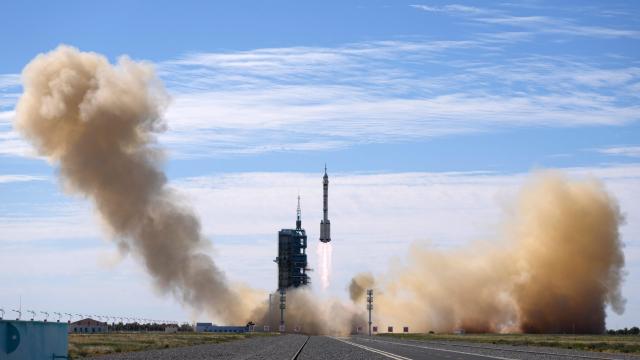China secretly tested a new hypersonic missile this past August, according to a new report from the Financial Times. And while the missile reportedly landed quite a distance from its intended target after circling the globe, the test suggests China is much further along in its development of hypersonic missiles than U.S. intelligence had previous thought.
While intercontinental ballistic missiles (ICBMs) travel along an arc, exiting and re-entering the Earth’s atmosphere in order to hit a target on the other side of the globe, hypersonic missiles stay in low orbit and are easier to manoeuvre. Hypersonic missiles are slower than ballistic missiles, but hypersonic missiles are harder to defend against, at least hypothetically, because they work to evade early detection systems.
In fact, sources who spoke with the Financial Times claim China theoretically has the ability to send its experimental hypersonic missiles over the South Pole to reach targets in the U.S., a trajectory where Americans are much more vulnerable because the U.S. military spent the entirety of the Cold War preparing for a North Pole-style attack coming from the former Soviet Union. The U.S. has no known equivalent to the Distant Early Warning (DEW) Line in the southern hemisphere.
The new hypersonic missile was reportedly launched with one of China’s Long March rockets — the same rockets used to put China’s domestic satellites into space.
From the Financial Times:
The missile missed its target by about two-dozen miles, according to three people briefed on the intelligence. But two said the test showed that China had made astounding progress on hypersonic weapons and was far more advanced that U.S. officials realised.
Both ICBMs and hypersonic missiles are launched using technology built on the backs of space travel in peacetime, meaning China’s 21st century accomplishments in rocket and rover technology should definitely be viewed through the prism of the New Cold War — just like U.S. space technology since NASA’s inception.
The Financial Times notes that China’s new hypersonic missile is being developed by the China Academy of Aerospace Aerodynamics, which conducts research under the China Aerospace Science and Technology Corporation, the same group that builds rockets for China’s peacetime space program. And while the China Academy of Launch Vehicle Technology publicly announced a 77th and 79th launch of Long March rockets, on July 19 and August 24, respectively, it’s not clear what happened to that 78th test. The Financial Times suggests the 78th test was likely the rocket carrying China’s hypersonic missile glide vehicle.
Both the U.S. and Russia are known to be working on hypersonic missiles, and Russia occasionally brags about the progress its made with the technology, including the Avangard system. Even North Korea claims to be working on a hypersonic missile, though it’s not clear how far they’ve gotten with the cutting edge weapons.
In the wake of news about the hypersonic missile test, Republicans called for harsher actions against China, without really saying what those should be.
“This test should serve as a call to action. If we stick to our current complacent course — or place our hopes in bankrupt buzzwords like ‘integrated deterrence’ — we will lose the New Cold War with Communist China within the decade,” U.S. Congressman Mike Gallagher of Wisconsin said in a statement.
“The People’s Liberation Army now has an increasingly credible capability to undermine our missile defences and threaten the American homeland with both conventional and nuclear strikes. Even more disturbing is the fact that American technology has contributed to the PLA’s hypersonic missile program,” Gallagher continued.
What happened to treaties that prohibited the development of new weapons systems such as these, like the 1987 INF Treaty that banned new intermediate-range nuclear weapons that can travel between 500km and 5,470km? For one thing, China was never party to the INF Treaty. But also, the Trump regime said Russia was in violation of the treaty and rather than get President Vladimir Putin to get back in compliance, former Secretary of State Mike Pompeo unilaterally pulled the U.S. out.
The New Cold War clearly won’t be cooling off anytime soon.
Editor’s Note: Release dates within this article are based in the U.S., but will be updated with local Australian dates as soon as we know more.
